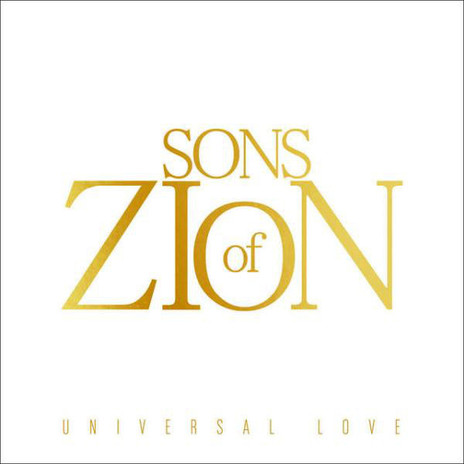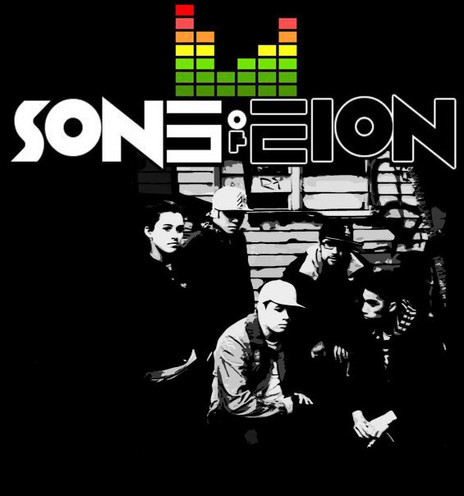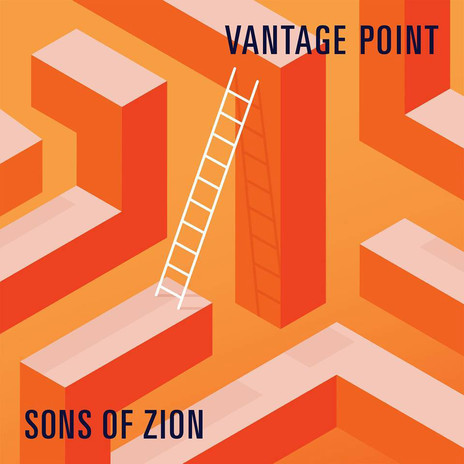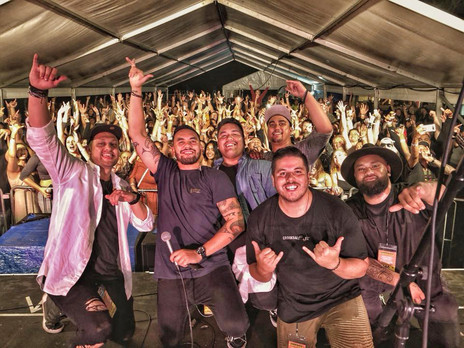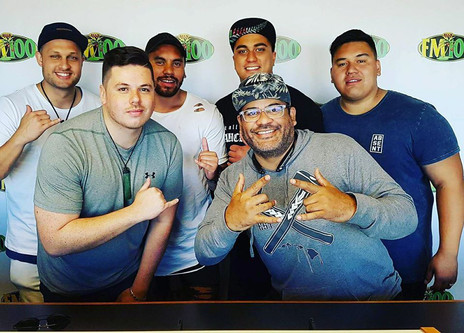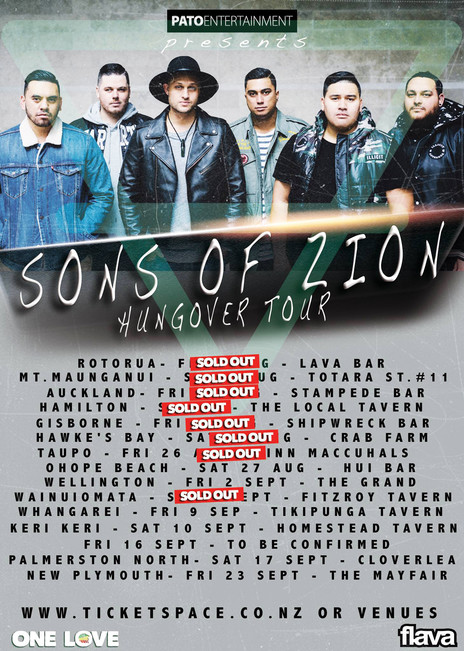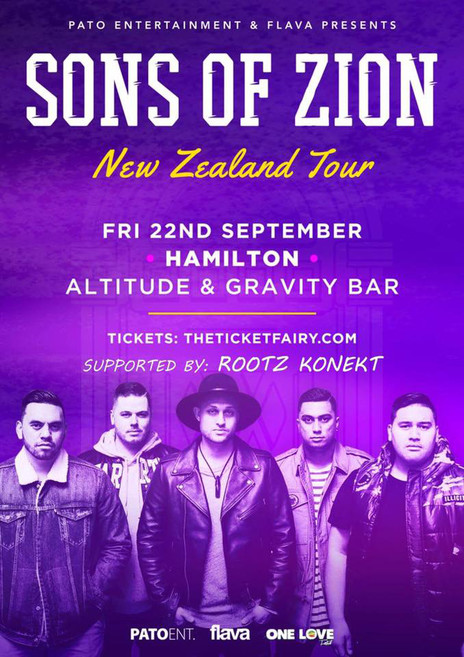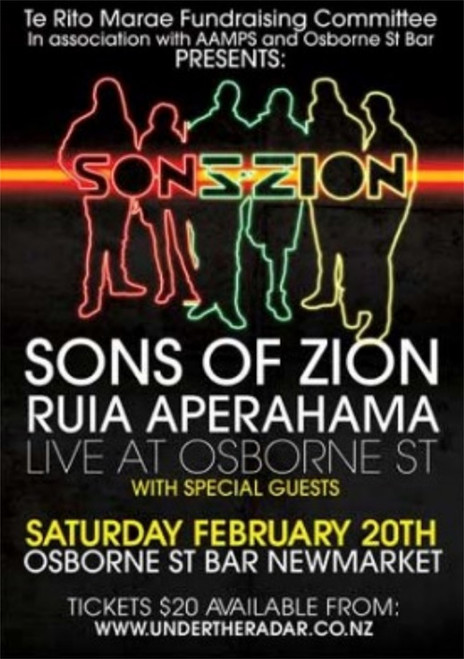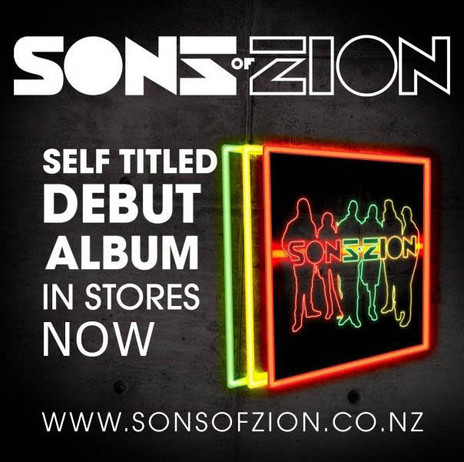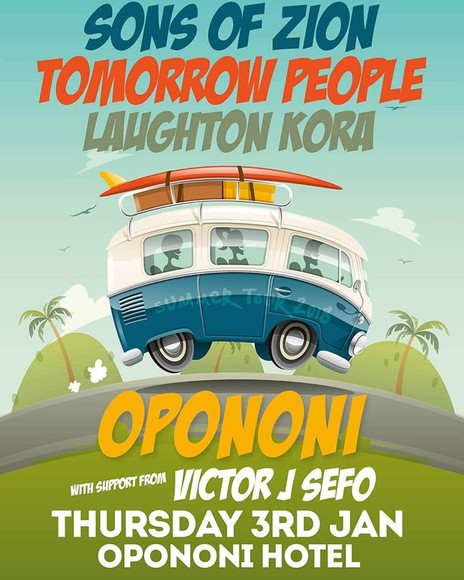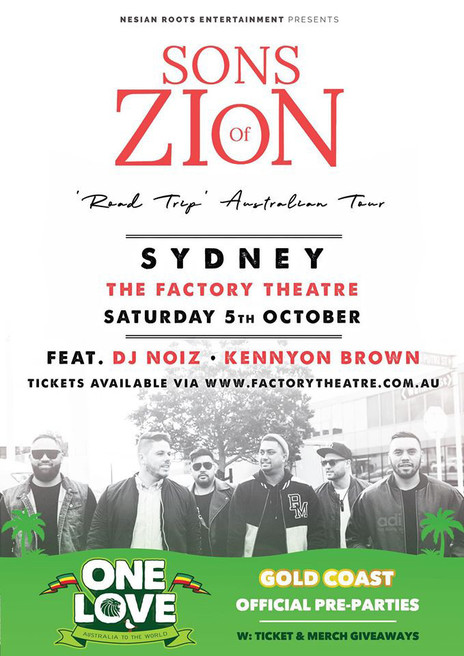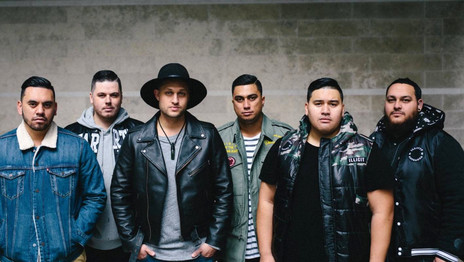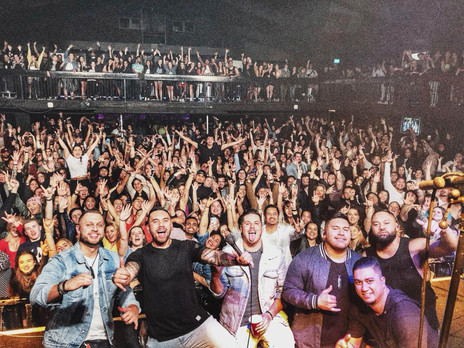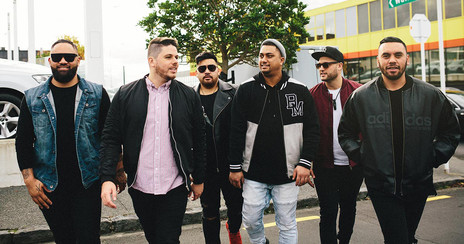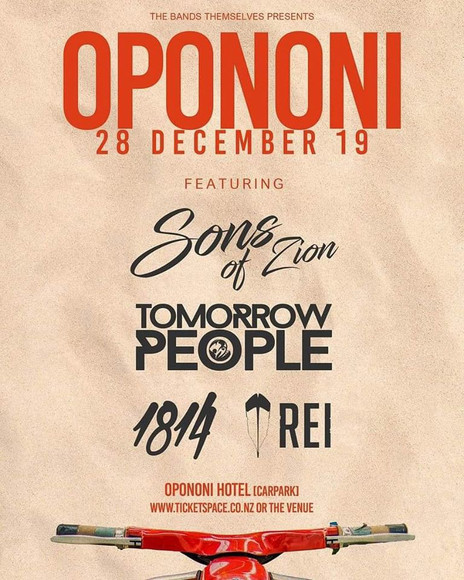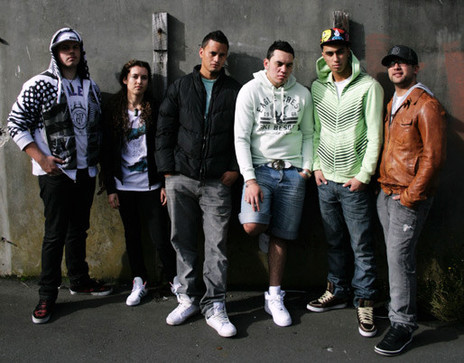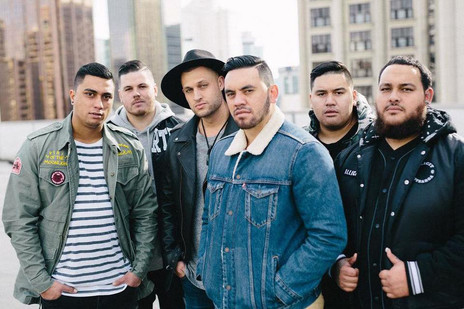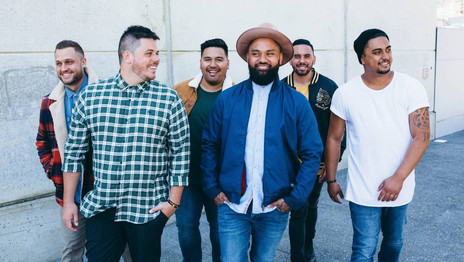As Eriwata recalls: “Our churches would come together occasionally to have a joint service. He was in his youth band and we were in the Auckland one, but at those joint services the bands would combine so that’s when we first started playing together. Over time, Rio moved to Auckland and joined our youth band, so we ended up having a jam at my house and came up with some original ideas.”
In the youth band they sometimes dropped bits of reggae into the religious songs they were practising and pursued this direction when it came to writing originals. Eriwata had an old friend, Dylan Stewart, who had been playing bass since he was very young. They got him down from Whangarei, while Latimer played keyboards, Eriwata played drums, and Panapa was the main vocalist and guitarist.
They hurriedly recorded an EP so they could release it at the 2007 Soundsplash.
Eriwata says it moved quickly from there: “Our first show was a 23rd birthday for Olly Coddington. He’s still on TV today hosting random shows. We won the Soundsplash competition not long after. That was one of our bigger breaks. The prize was to be the first band to open the festival. They had a battle of the bands at Alhambra in Ponsonby and we won.”
They hurriedly recorded an EP so they could release it at the 2007 event. Eriwata already knew the fundamentals of recording – he completed studies in sound engineering at the School of Audio Engineering (SAE) a couple of years earlier. He also had access to equipment because he worked at a music store at the time, so he set up a space for them to practise and record in his garage.
Eriwata wrote a number of early songs for the group, but these turned to be in an uncomfortable range for Panapa, so Eriwata sang them himself while playing drums – he had a good voice, taking after his father Richard Eriwata, a popular singer in the 70s and 80s, who appeared many times on television. Eventually, Sam moved up the front so he could sing and play percussion, while also triggering sounds from a sampler pad (giving a unique aspect to their sound). Tawhiri Littlejohn took over on drums and they subsequently added a lead guitarist too, Harlem McKenzie.
They sent videos of themselves performing to the organisers of university orientation and managed to score a support slot with The Black Seeds for O week (in front of 2000 people), then went on to tour with big names – Kora, Katchafire, Opensouls, and House of Shem. They connected with their Māori roots by taking part in events such as the Māori Side Tour in 2008, the Native Noise Waitangi Day event in Ōrakei in 2009, and Ngāpuhi Fest in 2010. The latter was a homecoming of sorts since Eriwata, Latimer, Stewart, and Littlejohn are all Ngāpuhi (Panapa’s whakapapa extends to Te Arawa, Tūwharetoa, and Tainui).
Sons of Zion kept a foothold in the Christian music scene too, playing the Parachute Music Festival in early 2009. By this stage, Marika Hodgson had replaced McKenzie as lead guitarist. She was one of two Whangarei musicians in the band, while Panapa had spent his formative years in Rotorua, which motivated the band to tour regularly outside the main centres.
Spreading good love throughout Aotearoa
In October 2009, the band released their self-titled debut album through Sony Music. They’d been put in touch with the label through their management and booking agency – the Music Agency, run by industry veteran Dean “Dino” Lawton (ex-Tadpole).
To record parts for the album they had hired out rooms at practice space, Dr Music, on the North Shore. Eriwata recorded other tracks in his spare room at home or ran cables to the garage so that he could record directly to the computer from there. Through a bit of experimentation, the band were able to achieve an increasingly professional sound.
Aside from the reggae sound that formed the heart of the tracks, there were also aspects of rock, metal, dub and roots – a mix that had been popularised by acts they’d played with, such as Kora and Katchafire. A prime example is the single ‘Waiting Right Here’ which goes from skanking off-beats to metal guitars and even features rapping by Hazadus (longtime collaborator with Che Fu). The reggae vibes spread from the slow dub groove of ‘Genesis’ through to good time tracks like ‘Be With You’.
Sons of Zion were now established enough to take a slot at one of New Zealand’s premiere reggae festivals – Raggamuffin (in 2010) – and to do long tours throughout the country. Their mid-year tour with Sweet & Irie took in 11 dates.
They needed to push even harder if they wanted to break through to the top rung of the local reggae scene, so they spent the next year writing new songs and touring regularly. This included playing festivals such as Exodus in Tauranga (at the end of 2011) and doing their first shows in Australia.
They continued to practise and record in Eriwata’s garage, but for their second album they booked time at York Street Recording Studios where they worked with experienced sound engineer Andrew Buckton. However, working towards an album was a long process and it took more sessions at Roundhead Studios to bring it to completion.
There were more line-up changes over the course of the recording. Hodgson had less time for the group, because she was in demand as a bass player and went on to play with Hollie Smith, Rhian Sheehan, and Teeks (as well as releasing her own material as Sorrento).
‘Good Love’ quickly gained ‘A’ rotation on Mai FM, Flava, and Nui FM.
Other new members initially came on board when group members couldn’t make live shows. Phil Peters would regularly fill in for Littlejohn on drums, then ended up playing on three tracks for the album. Curtis Wiringi filled in as a second keyboards player when Eriwata couldn’t make a performance, which led him to record backing vocals for the group and contribute songwriting ideas for a few tracks.
In late 2012, the first single ‘Good Love’ was released ahead of their second album and the song quickly gained “A” rotation on Mai FM, Flava, and Nui FM (supported by more festival slots at Raggamuffin and Pacific Vibes). Another big single followed with ‘Tell Her’ joining ‘Good Love’ in topping the Urban and New Zealand airplay charts, while also pushing past a million views on YouTube.
Eriwata felt these two tracks had a big impact on their approach to songwriting: “Previously we’d been musician’s musicians, who wanted to record stuff that was flashy with lots of our gospel chops and us doing whatever the coolest thing was as a musician. When ‘Good Love’ and ‘Tell Her’ came out they were more stripped back and poppy. That was the first time we got over a million views on YouTube for both of those songs, so we thought we should go more along those lines and create more songs that were simpler.”
Those singles created a great platform for the album Universal Love, which came out in September 2013 and raced to No.3 on the charts. The album had some surprise features, including rapper Young Sid (Sidney Diamond from Smashproof) on ‘Try Again’ and R&B singer Pieter T on ‘Be My Lady’, which eventually racked up over nine million streams. Equally successful was their team-up with Tomorrow People, whose own reggae album had reached No.3 the previous year. They combined forces on ‘Superman’ and reached the Top 20 of the singles chart (and won best video at the 2014 Waiata Māori Music Awards).
That same year, Panapa put together the Aotearoa Reggae All Stars to record a cover of the Herbs song ‘Sensitive To A Smile’ in order to raise awareness and funds to fight against child abuse. Alongside Sons of Zion on the track were a who’s who of local reggae: Katchafire, Che Fu, 1814, House of Shem, Tomorrow People, Ria Hall, Three Houses Down, Majic Paora, Chad Chambers, NRG Rising, and Tasty Brown. It hit the No.2 spot on the chart in July 2013.
By the end of 2013 Sons of Zion had achieved a number of firsts, headlining their biggest show at the Studio in Auckland, performing in Samoa and doing signing sessions in record stores across the country. They were now at a level where they could play the biggest festivals in New Zealand. In 2014 alone they played Homegrown, Raggamuffin, One Love, and East Coast Vibes. They did their first performance in Japan at PacificRootsFest, which was arranged through their manager Dino Lawton (who had previously taken over other New Zealand acts, such as Awanui Reeder from Nesian Mystik).
In between albums, the Sons of Zion released one of their biggest online hits, ‘Stuck on Stupid’. This was the first track produced by a new member to the group, Matt Sadgrove. He had initially been brought into the band to fill in as a second keyboardist and saxophone player. However, it turned out he was an amazingly talented musician who had studied at the prestigious music school Berklee College in Boston and worked in the music scene in LA before returning to New Zealand.
‘Stuck on Stupid’ also featured hard-working reggae singer Israel Starr, who grew up in the 12 Tribes of Israel Church (and is son of The Mighty Asterix). The melodic vocals, big dub bass sound, and ragga toasting meant the song had something for every reggae fan. Yet the band were still blown away when it gained massive radio play in Hawaii, where Katchafire had already created interest in New Zealand reggae. Popular Hawaiian radio station Island 98.5 ended up naming ‘Stuck on Stupid’ their second biggest song of 2015 and helped it to gain over eight million streams online.
The final pieces fall into place
In 2015, Sons of Zion finally found a line-up that would last. Founding members Eriwata, Panapa, and Latimer remained, along with Matt Sadgrove who moved to bass after Stewart left (though Ara Adams-Tamatea from Katchafire and L.A.B. filled in for one Australian tour). They also brought on board Caleb Haapu. Eriwata recalls: “We’d always been a fan of Caleb since he played in another band, L40, which we really liked and they were coming to an end. Rio was moving away from playing guitar, so we thought Caleb would be an amazing addition not only for his singing, but his guitar playing.”
One thing that had caused a disruption over the previous years was the regular changes of drummer. For a while they had Dylan Elise on the drum seat, but he left to travel overseas so the position was taken by Zane Graham from L40 before they finally found Ross Nansen. Nansen had wide experience from playing with The Levites, four musicians who met in a church band and went on to back acts like Stan Walker and Vince Harder.
AT THE MAYJAH RAYJAH FESTIVAL IN HAWAII They played to one of their biggest overseas audiences.
The band recognised the change in music that came with the arrival of streaming music in New Zealand and moved toward releasing one-off singles over the next two years – ‘I’m Ready’ and ‘Fill Me Up’ in 2015, then ‘Hungover’ and ‘Now’ in 2016. These continued the band’s popularity online – especially ‘Fill Me Up’ which reached four million streams. Part of their success was through the big Australasian reggae playlists on Spotify and this led them to find a new audience across the Tasman, which they backed with extensive touring.
They played in front of one of their biggest audiences overseas when they did an evening slot at the Mayjah Rayjah festival in Hawaii, though Eriwata found the culture was very different: “It was more chilled out than a festival over here. In New Zealand, everyone is in party mode – everyone is smashed and having a mean time. Over there, there’s hardly any drinking going on and everyone’s watching the show from picnic spots. Plus, there are noise restrictions so it’s half the volume of a New Zealand show. Way different vibe. It was amazing just being there and watching people react so positively to our music. Guam was another crazy show that we played that year. It was a totally different culture and the promoters there treated us like kings!”
Touring took them to Japan, Guam, Rarotonga, and Tahiti. Back home, they were more popular than ever and sold out many of the shows on their 15-date tour of New Zealand in September, 2016. They appeared on the Grand Final of Homai Te Pakipaki (one of Māori Television’s most popular shows) and began 2017 with a slot on the main stage at Womad.
However, Eriwata found they were struggling to keep up energy for the group and this was part of the reason for their reduced musical output. “We went through a lull where we didn’t really have any direction. We weren’t as passionate, I guess. We were getting older, babies were arriving, and there were family commitments. Finally, we got through that and said – ‘no let’s give this a proper crack again and get back into it’.”
The band had always taken a primary role in recording and producing their own work, but now decided they needed their own professional space. They built No Filter Studios, which also allowed them to record other acts and do TV production work, with Sadgrove bringing across some of the work he was already doing.
One of the projects they worked on was writing and recording music for the group Maimoa, which included playing all the live instruments for the tracks. Among these songs was te reo Māori hit ‘Wairua’, which subsequently went viral on YouTube, with nine million views (and another five million streams).
Sons of Zion showed a new side to their music by releasing The Jukebox Suite (2017) which veered away from reggae on three of its four tracks. ‘Live It Up’ was a funky modern-pop track and ‘The Way That I Am’ was a dancey soul stomper, while the single from the EP was ‘Is That Enough’ which had a slow soul groove. This made it the perfect track for a cameo by Aaradhna, who took a verse and joined in for the final chorus and outro. The EP pointed the way forward for the group, keeping one foot in reggae while reaching into new genres when the mood took them.
Reggae stars … and pop stars
For their next album, Sons of Zion decided they would lay it all on the line by quitting their day jobs and focusing entirely on the group. Up to this point, they relied on the sympathy of their employers to take long breaks for touring, but now they would no longer have to juggle music and paid employment.
This new openness to writing in genres beyond reggae paid immediate dividends. Their first single ‘Drift Away’ was written by bassist Matt Sadgrove. He originally demo’d the idea by recording it on his phone – just a basic guitar riff played on an acoustic guitar and some quietly sung lyrics. He had the image in his head of Leonardo DiCaprio washing up on the beach in the Christopher Nolan movie Inception after having lost his girlfriend. Sadgrove wanted to capture the feeling of bittersweet nostalgia.
‘Drift Away’ became the most played song on NZ radio for 11 weeks straight.
Eriwata was intrigued by the new sound: “It was so different from what we’d been writing before. You could just tell straight away that it was going to be a hit. Caleb has a very soft, smooth tone to his voice which really came out on that track too. When we played it to people at radio, they said they couldn’t wait to put it on air and that it was the best song we’d ever done. We got heaps of support from Mai FM and Flava, then that broke us into ZM and the Edge as well. Everyone loved it.”
The stripped-back tune – just vocals and an acoustic guitar – sounded nothing like the music they’d released previously. But it worked for them, becoming the most played song on NZ radio for 11 weeks straight and reaching No.17 on the charts.
At this point, Auckland remained their biggest source of streams, but the cities that followed directly behind in terms of streaming numbers were Brisbane and Sydney (following multiple Australian tours over the previous two years). It also helped that their management had been taken over by Jarrod at Nesian Roots, a company that specialised in touring New Zealand acts across the ditch. Their cross-Tasman fanbase helped ‘Drift Away’ reach the astounding figure of 16 million streams (and counting). They found themselves selling out 1000-capacity venues and even having to book two performance nights in a row in Brisbane.
The subsequent album Vantage Point (2018) showed the scope of the band: on one track they brought in Israel Starr for a classic reggae track, ‘Mash It Up’, while on the downbeat track ‘Same Old Me’ they brought in a string quartet (Ross Nansen’s wife and sisters happened to be violinists and cellists).
The album shot into the Top 20 and saw the group win the highly competitive “best roots band” category at the New Zealand Music Awards that year.
More surprisingly, Vantage Point reached No.8 on Billboard’s reggae chart, which coincided with their first tour to the mainland of the US that same year, including a slot at the Island Reggae Festival in California alongside Katchafire and Sammy J. By this stage, Sons of Zion already had a solid footing in Hawaii and the song ‘Early in the Morning’ featured singer Fiji (who was born in Fiji, but is a staple of the Hawaiian music scene). At the Island Music Awards in Hawaii in 2019 they were nominated for group of the year.
Meanwhile, Sons of Zion had become one of the most popular live acts in New Zealand. It came as no surprise when Six60 asked them to be among the support acts for their massive show at Western Springs, which drew an audience of 60,000 people.
“We’d met Matiu from Six60 many years before that and spent time hanging out with him, so he requested us for that show, because of our relationship, as well as how big we were in the market. It was one of the best experiences I’ve ever had onstage. Just seeing that many people out in front of you and performing for them was awe-inspiring. We wore in-ear monitors, but now-and-then I’d take one out and hear them singing every song word-for-word. It was mind-blowing!”
Sons of Zion also retained a sense of pride in their roots and in 2019 took time out to re-record ‘Drift Away’ in te reo (as ‘Pōtere Ana’) for the compilation, Waiata/Anthems. Caleb Haapu didn’t speak te reo fluently but was determined to work hard so that his pronunciation on the track was as perfect as it could be (despite the speedy flow of the lyrics). The resulting recording showed the song could work just as well in either language and it became one of the standout tracks on the album.
The group’s four songwriters then decided they needed to seek some new inspiration, so Panapa, Sadgrove, Eriwata, and Latimer spent 10 days in LA. They primarily went there to write new songs but decided to reward themselves by booking time at Larrabee Studios, where Bob Marley, Alicia Keys and Tupac had previously recorded.
The first song to see the light of day from these sessions was ‘Road Trip’ – an ode to taking off across the country for a holiday. It was inspired by their own experiences touring, but most New Zealand listeners would recognise the feeling captured in the song of leaving the working week behind and hitting the road to a summer spot.
During the Covid 19 lockdown of 2020, Rio Panapa fronted his own show on Māori Television, Lifted. The 12 episodes caught up with other musicians who, being trapped at home, didn’t have the chance to play live as they usually would have, so each show featured a performance of a couple of songs. Guests included Stan Walker, Fran Kora (Kora), Joel Shadbolt (L.A.B.), Katchafire, and many more.
By that stage, Sons of Zion had over 50 million streams on Spotify and 15 million views on YouTube. Both their previous two albums had gone gold, while ‘Drift Away’ had gone platinum (and their collaboration with Aaradhna ‘Is That Enough’ had gone gold). They were now mainstays of the local live scene, could play long tours through the country and appear at the biggest local festivals year-after-year, as well as packing venues in Australia and Hawaii.
Sons of Zion have shown that being a great live band could transfer across to getting radio play and gaining listeners online if you were willing to put the work in. As a result they became dominant in all three spheres. From jamming in a garage to playing the biggest stage in New Zealand, Sons of Zion are now one of the biggest reggae bands in the country – and pop stars to boot.
